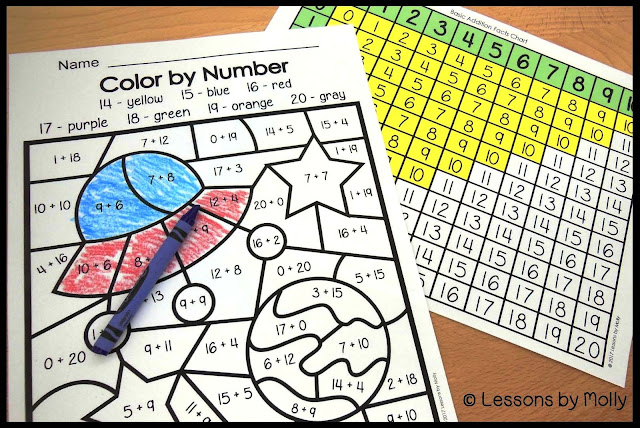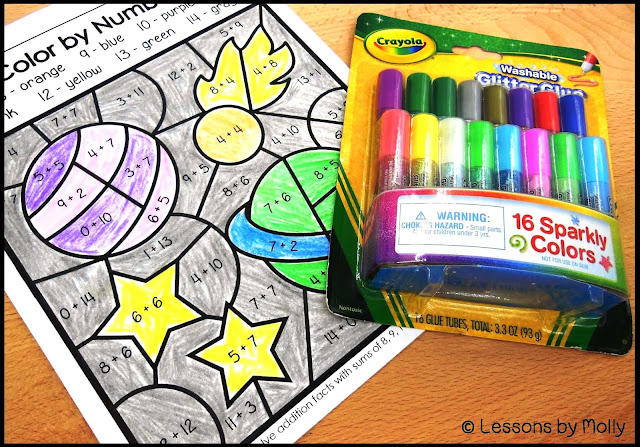If you're using iPads in your classroom, your students have undoubtedly used "Color by Number" apps on their devices. However, there's nothing like coloring your own picture that can be proudly displayed on a classroom bulletin board or on the refrigerator at home.
I'd like to share a few strategies for making accommodations and modifications with my color by number math facts printables. Using these strategies means that many of your students can have success with the same work!
1. Mark the Legend (key/code). What teacher hasn't done this before! My color by number printables are for addition and subtraction skills and not for reading skills! There may be a child that is a whiz with adding and subtracting but hasn't learned to recognize his/her color words yet. Remove an immature reader's stumbling block by color coding the color words before he/she begins.
2. Divide Work into Chunks. If you've been an educator for a while, you know that this is a popular strategy used to provide an accommodation for a child that can easily become overwhelmed by large amounts of work. Maybe you've circled half of the math problems on a worksheet and asked a student to complete the circled portion. You can use the same strategy with color by number printable pages. One way to do this is to assign parts of the picture. The rocket picture (shown below) could be divided into three segments. The exhaust and the stars could be colored as the first step. Then coloring the rocket could be assigned. The last step could be to color in the background. Breaking the work up into chunks can enable a child into visualizing the work as a less tiresome undertaking.
3. Eliminate Part of the Work. This strategy is very similar to number two. Color some of the sections for the child before giving it out. Maybe you're thinking, "What! I don't have time for that!" I know it's not practical as a classroom teacher to spend your valuable time coloring work. This where afternoon helpers from a higher level grade come in handy. They'll love to color some work for you! If you have access to a color printer, you can print a color copy of the partially completed work and use it as a master to print additional pages. Make sure to wipe off the printer's screen so that no crayon marks are left behind!
4. Change the Form of Art Media. Crayons have traditionally been used with color by number printable sheets but other coloring materials can be used as well. Some children aren't keen about using crayons. Perhaps the small muscles in their fingers are underdeveloped and they are feeling hand fatigue early on in the coloring activity. Consider magic markers, triangular shaped crayons, colored pencils, paint balls, or watercolors. Be prepared for a bit of mess and with colors mixing together if they use watercolors! By the way, I love that triangular crayons don't roll off of the table!
Crayola has some crayons called Twistables ® Slick Stix. They make coloring a snap and leave deep, rich colors. Twelve colors are in a package which includes every color needed except for the pink. Students can tolerate using their regular crayons for the pink section.
5. Provide Manipulatives and Supportive Devices. Math standards may require students to commit their basic addition and subtraction facts to memory but some students haven't reached that milestone yet. Allow them to use counters, numbers lines, or calculators to find the answers to the addition and subtraction problems.
I found calculators (shown below) at Walmart a few years ago. They were a dollar a piece. If you're looking for good, cheap calculators, consider making your purchase during the summertime "Back to School" sales.
Math facts charts can assist students that are able to visually track (horizontally and vertically) simultaneously on a grid. Here's a math facts chart for adding within ten the you can download: FREE MATH FACTS CHARTS. One of my color by number pages is adding within ten. The other addition pages vary from adding within ten and on up to adding within twenty.
6. Give the Student the Answers. Most of the strategies I've mentioned fall into the category of being an accommodation and not a modification. This depends on what your objectives are for assigning the color by number sheets. The use of calculators might also hinge toward being a modification. It's unrealistic to expect a child that has significant deficiencies in addition and subtraction facts to do the work that everyone else has been assigned. Here's an opportunity for you to transform that child into feeling like the "superhero" for the day! He/she will gain exposure to the basic facts without the requirement of solving facts. Give the child a sheet with all the answers included and assign him/her as the job of being the "Answer Key Maker"! You'll also save yourself the color ink from printing the answer keys. I've included pages for this purpose in my Color by Number Basic Addition and Subtraction Facts resource. All of the sections have the complete number sentences within the sections that are to be colored. The child will need to be able to identify the sum or the difference and use the color keys printed on the pages. An example of this is shown below.
Depending on your students' needs and the manner in which you are differentiating, you will not have the same objectives for all students. Here are some possible objectives.
* Students will solve addition and subtraction facts fluently.
** Students will solve addition and subtraction facts using manipulatives.
*** Students will solve addition and subtraction facts using supportive devices.
**** Students will gain exposure to addition and subtraction facts.
***** Students will identify the sums and differences in addition and subtraction sentences.
****** Students will use a key to color appropriate spaces.
Here's the final strategy and this post is almost finished!
7. Offer a Natural Incentive. Offering an authentic incentive is an excellent strategy for motivating students to finish work! It might be enough motivation for some of your students to see their classmates' finished work (proudly displayed on a classroom bulletin board or school's hallway) to spur them on toward completing their own work! Allow the children to embellish their finished masterpieces with something special like glitter paint.
I found paint for sun-catchers at Walmart and had no idea if it would work on paper. I tried it out and it worked well! The pink circles are much brighter than the pink stripes that are on the planet that the alien is standing on.
Addition and subtraction "Color by Number" printables can be one of your best allies in promoting fluency with basic math facts. My Color by Number Basic Addition and Subtraction Facts printables have about fifty problems for the students to solve per page. The plain practice page shown below has barely half that number of problems.
Let's face it; coloring a picture of our planet is much more engaging!
My resource includes six printable pages plus color coded answer keys. There's also the duplicate pages with the answers given for your students that are the "Answer Key Makers"! There are two subtraction facts printables and four addition facts printables. The "Earth" color sheet (shown above) is for adding three numbers with sums in the range of 11 to 18.
If you would like to view this product at my shop, click on either of the images shown below. The price is $2.00 for a limited time.

















Great ideas!! Thanks for sharing.
ReplyDeleteHi Frances!
DeleteThank you for reading the post on "Color by Code" strategies.
Sincerely,
Molly